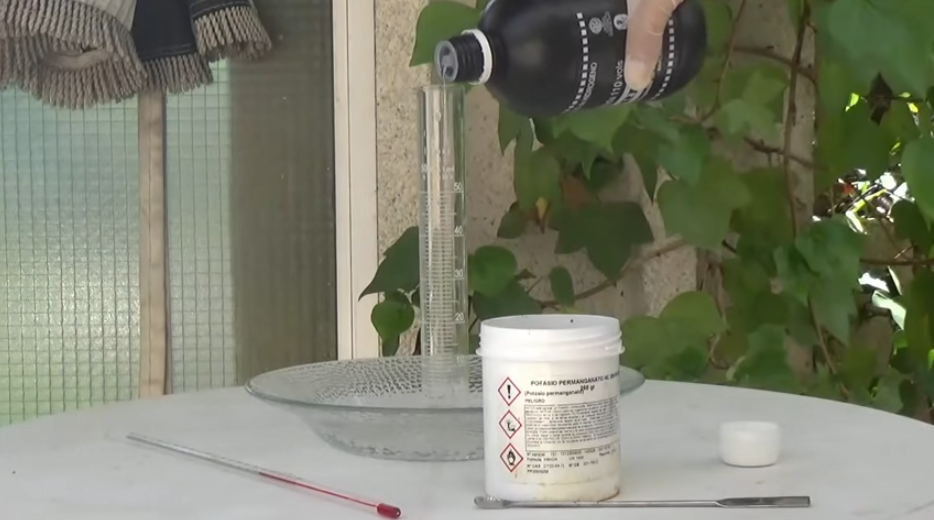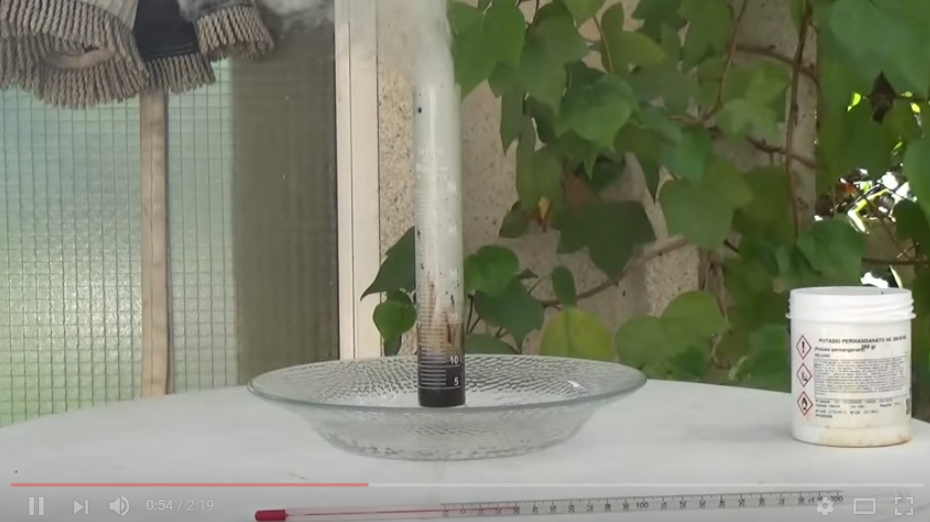GENIE OF THE LAMP EXPERIMENT SHEET
| Theme | Redox Reaction |
| Category | Experiments Exhibition, Chemistry Experiments |
| Main products | Potassium Permanganate, Hydrogen peroxide |
| Short description | This is a spectacular experiment where we are going to decompose hydrogen peroxide (H2O2) into oxygen (O2) and water (H2O). This decomposition reaction gives off a large amount of oxygen, generating a large amount of smoke that comes out of the container. Hence the name "genie of the lamp". |
MATERIALS FOR THE EXPERIMENT
The materials we need for the experiment are:
- Potassium Permanganate -> en Alquera.com
- Oxygenated water. Preferably from 110 volumes or 30% concentration. It has to be bought in pharmacies, it is not sold in supermarkets.
GENIE LAMP EXPERIMENT STEP BY STEP
-
- Pour 5ml of 30% or 110 volumes of hydrogen peroxide into a glass container.

-
- Then we introduce 2 grams of potassium permanganate.

-
- We observe the reaction that takes place, giving off a large amount of oxygen and water vapour.

VIDEO EXPERIMENT
VIDEO TUTORIAL
EXHIBITION VIDEO
TECHNICAL EXPLANATION OF THE EXPERIMENT
Both potassium permanganate and hydrogen peroxide are strong oxidisers, and the decomposition reaction of hydrogen peroxide releases a large amount of oxygen, O2, and is exothermic.
In the reaction between potassium permanganate and hydrogen peroxide, it will be the permanganate that oxidises the peroxide, generating a strongly exothermic reaction, instantaneous and very visible as a large amount of O2 and H2O vapour is released.
REACTION BETWEEN POTASSIUM PERMANGANATE AND HYDROGEN PEROXIDE
MnO4-(aq)+H2O2(aq) -> Mn2+(aq)+O2(g)+H2O
The oxidation - reduction half-reactions and electron balance will be as follows:
- Reduction: MnO4- + 8 H+ + 5 eMn2+ + 4 H2O
- Oxidation: H2O2->O2 + 2 H+ + 2 e-
The simplest balanced equation is as follows:
2 MnO4-(aq) + 5 H2O2(aq) + 6 H+(aq)->2 Mn2+(aq) + 5 O2(g) + 8 H2O(l)
We have performed this experiment, using first hydrogen peroxide at 30% (a much higher concentration than ordinary hydrogen peroxide (the one we have at home) and ordinary household hydrogen peroxide, and you can see the difference in the reaction, due to the difference in H2O2 concentration of both components.
It can be seen that we have used very small amounts of compounds for the experiment, but nevertheless the strength of the reaction is very palpable. In the case of larger quantities, it is necessary to take into account the exothermicity of the reaction and to carry it out with all precautions.
MORE EXPERIMENTS
In this section you can see more Chemistry Experiments

very beautiful
thank you XD
Potassium is not missing in the reaction (potassium permanganate).
Hello,
Yes, it is simplified, as potassium does not undergo ionic modification. Potassium hydroxide KOH is produced in the reaction
liquid soap is missing
So what does the equation ???? look like?
Very good, thank you very much
One question
I would like to know if you have information on how much pressure (psi) this reaction generates?
Hello brother, this reaction produces a gas, oxygen (O2), which is the one that can produce some pressure change due to its gaseous state. However, for this to happen the reaction needs to be hermetically contained in a closed container. If this condition is met, it is possible to calculate the pressure inside the container using the ideal gas law, for which you will need: the volume of the container (taking into account subtracting the volume occupied by the aqueous solution where the reaction takes place), the amount of oxygen present in moles (easily calculated if you know the amount of permanganate added), the temperature and the value of R, 0.08206. From this you will get a pressure in atm, easily converted to psi.